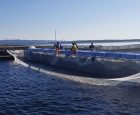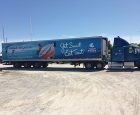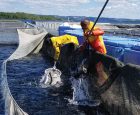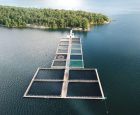
A closer look at Cole-Munro Fisheries
February 5, 2019
By Ron Hill
The pristine waters of Lake Huron have long drawn attention from anglers in search of great trout and char fishing. It is no surprise that those waters are also excellent for farming rainbow trout (Oncorhynchus mykiss).
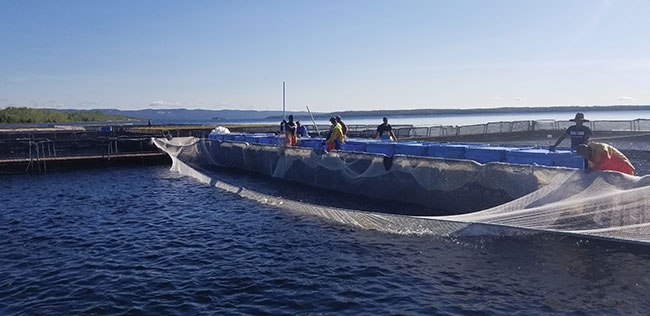 Fish are seined up before harvest.
Fish are seined up before harvest. Manitoulin Island, the largest freshwater island in the world, separates the north channel from Lake Huron proper, creating a sheltered pocket where aquaculture has thrived for decades. Just northeast of the town of Little Current, the Cole-Munro Group, Ontario’s largest trout producer, operates four sites around the island.
Area manager Jason Hughson has spent 25 years raising rainbow trout on Lake Huron. “I started as a co-op student in 1993 at my high school and was so interested that I took the aquaculture program at Fleming College in Lindsay, ON and came back to start work on the farms full time. I’ve been doing it ever since.” Joining the Cole-Munro team as the manager of the Wabano Channel site in 2013, Jason has overseen a massive expansion as the company added or acquired sites in 2014, 2015 and 2018.
Fingerlings
Fingerlings are bought from hatcheries in the Bruce Peninsula in the spring and fall and trucked to the island where they are loaded into the portable net cage at the harbour. Once the portable cage is stocked it is slowly but surely pushed out to the site.
The trip from the harbour to the sites takes several hours and must be done in good weather. “We can only go as fast as the fish can swim, so it’s not very fast and the weather must be right,” says Hughson. Once the portable cage arrives it is pushed up to an empty pen and the net full of fish is transferred from the portable to the permanent cage. Workers then install new nets on the portable cage and it is pushed back to town to await the next truck load.
Winter woes
Fish are harvested continuously except for two periods of the year, when the lake freezes up and when the ice melts and breaks up. As the weather starts to cool, staff continue to work as normal for as long as possible. As the lake starts to freeze and it becomes challenging to break ice with the boats, workers are assigned to each site to stay there and monitor the site until it’s safe to move across the ice. Each crew is effectively marooned at the site charged with maintaining the fish. Fish are fed all winter, though they eat little when temperatures are low. Supplies and feed are towed in via snowmobiles and harvested fish are towed out the same way. As the ice breaks workers must guard against ice floes and debris that would damage the system and nets. Only once the lake is safe for boat travel are the marooned workers relieved.
Strong bonds
Cole-Munro maintains a partnership with the local First Nations as the company operates within their traditional waters and some of their farms are attached to First Nation lands. The company supports native bands by making it a priority to hire natives. The Manitoulin area farms have taken on a brotherly theme. Four sets of brothers from the local community work for Cole-Munro, which helps to maintain competitive spirit among the staff. The best fish dipper on Lake Huron is a hotly debated topic around the cages. Besides Jason the manager, his wife Tanya and his son Ty, work for the company.
“My family has grown up on the farms. We’ve had the opportunity to stay and raise our kids in this amazing setting. It’s long days and lots of work but we love it. It really is a farmer’s life out here,” says Tanya. Cole-Munro has purchased the local processing plant in Little Current and plans to open it to process a portion of fish to support the local community and the local fish store with fresh and smoked fish.
Bright outlook
The future looks very bright for Cole-Munro’s Manitoulin Farms. Recent expansion has created great opportunities for increasing both fish size and number of fish produced. The first step is mechanizing more of the labour. “We want our Mink Island site to be the first cage site in Ontario to have an automated feed system,” says Hughson. Expansion has created a hiring binge at the company. “It can be challenging to attract experienced and educated workers, it’s a great place to live and play but a long way from urban centres. We hire a lot of locals but still need to find more staff,” Hughson says.
Cole-Munro trout can be found in Sobeys and Costco stores across Ontario. At Aquaculture Canada 2018, the group’s contribution in expanding the province’s freshwater aquaculture industry was acknowledged (ANA Sept/Oct 2018, page 11).
Advertisement
- InnovaSea acquires Water Management Technologies
- US patent given to company to grow gourmet-grade shrimp in enclosed, salt water system
